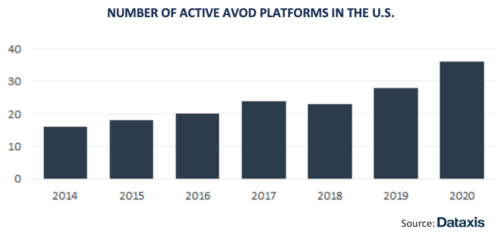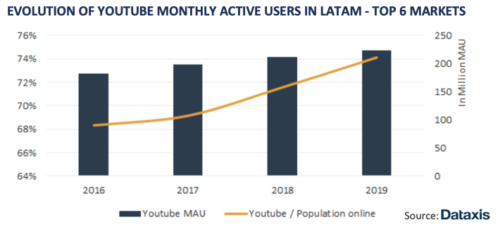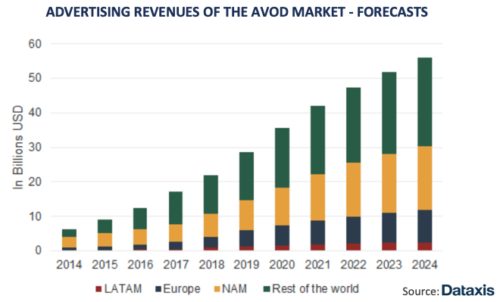Dataxis compares Europe, Latam with U.S. AVOD market
Thursday, July 2nd, 2020
The AVOD Landscape In Europe And Latam: A Comparative Analysis With The U.S. Model
The Covid-19 crisis highlighted a considerable increase in video consumption. In the U.S., Comcast has seen a 50% rise in VOD viewing over March and April 2020 for instance.

While SVOD and linear-OTT environments have become more overcrowded over the last years (households in the U.S. now subscribe on average to more than 2 SVOD services), AVOD has been increasingly seen as a shelter for a low-budget content consumption.
If this move toward AVOD is not completely new in the U.S., the market has become significantly more competitive since 2018.
Within this saturating market, only a few players are standing out in terms of monthly active users: Vudu, Pluto TV, Tubi, and more historical players such as Hulu, Roku Channel and, obviously, YouTube.

In total, we now count more than 15 services gathering more than five millions active users every month.
Advertising revenues, which used to be mainly captured by YouTube, are becoming more diversified between a growing number of players, able to monetize their audience in a country where the digital transition in ads-spending is accelerating. Some actors have started to go international, especially in Latin America and Europe.
While in the U.S. YouTube’s share is declining, the actor is still dominant in Europe. The reality of a fragmented TV market covered by numerous but domestic-only local players has hindered the emergence of a regional native player with the ability to compete. Mainly composed of broadcasters platforms, the AVOD content offer of the European market remains in a consolidation phase, leading consumers to prefer SVOD offers. For advertisers too, this nascent AVOD market is yet to become a strategic asset, as the user appropriation out of YouTube remains low. Nevertheless, few well implanted broadcasters in Western Europe have managed to monetize their audiences consistently: in France, the domestic AVOD market now accounts for 150 million euros and it reached more than 300 million euros in the UK.

But even if on a global scale the European AVOD market has been experiencing a limited growth so far, some actors have started to adopt hybridization strategies coming from the U.S., mixing AVOD and SVOD offers in order to maximize their reach. Besides, partnerships between domestic actors are increasing: the case of Discovery and ProSieben in Germany, which launched their joint freemium platform Joyn last year, is probably one of the most emblematic examples of that trend.
The arrival of international players such as Pluto TV, Rakuten, and eventually the soon to be launched in the U.S. Peacock, could give a kick-start to the European AVOD market. The Latin-American perspective remains heavily focused on YouTube’s unquestionable domination, which still accounts for more than 90% of the advertising revenues of the AVOD market. The penetration of the social video platform in the region has significantly increased over the past 3 years, and so did its penetration in terms of revenues among the total of the Internet net advertising revenues.
In the end, the AVOD market is expected to increase fast on a global scale, driven by the launch of new major players in the U.S., the growth of YouTube in Europe and Latin-America, and the consolidation of the Asian market.
Latest News
- Barb to start reporting TV-set viewing of YouTube channels
- SAT FILM selects multi-DRM from CryptoGuard
- Qvest and ARABSAT to launch OTT streaming platform
- ArabyAds & LG Ad Solutions partner with TVekstra in Turkey
- Freeview NZ satellite TV service to move to Koreasat 6
- Comscore expands YouTube CTV measurement internationally
